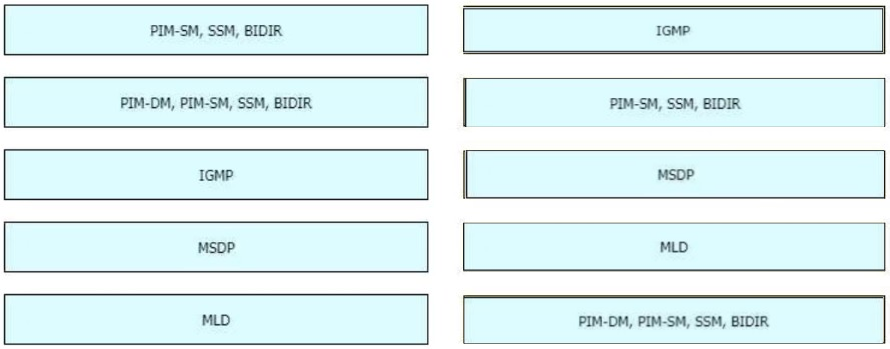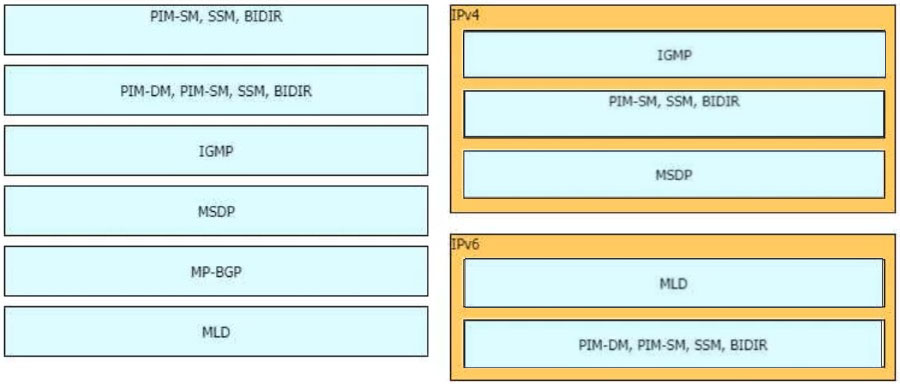Cisco® 400-007 Exam Practice Questions (P. 5)
- Full Access (302 questions)
- Six months of Premium Access
- Access to one million comments
- Seamless ChatGPT Integration
- Ability to download PDF files
- Anki Flashcard files for revision
- No Captcha & No AdSense
- Advanced Exam Configuration
Question #41
DRAG DROP -
Drag and drop the multicast protocols from the left onto the correct design situations on the right.
Select and Place:
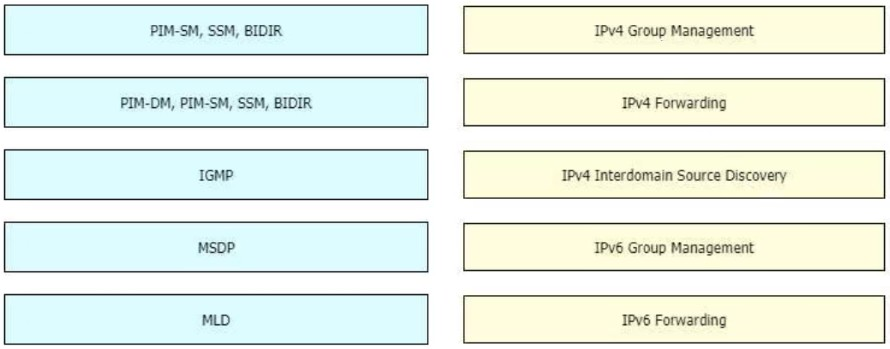
Drag and drop the multicast protocols from the left onto the correct design situations on the right.
Select and Place:

send
light_mode
delete
Question #42
Company XYZ, a global content provider, owns data centers on different continents. Their data center design involves a standard three-layer design with a Layer
3-only core. HSRP is used as the FHRP. They require VLAN extension across access switches in all data centers, and they plan to purchase a Layer 2 interconnection between two of their data centers in Europe. In the absence of other business or technical constraints, which termination point is optimal for the
Layer 2 interconnection?
3-only core. HSRP is used as the FHRP. They require VLAN extension across access switches in all data centers, and they plan to purchase a Layer 2 interconnection between two of their data centers in Europe. In the absence of other business or technical constraints, which termination point is optimal for the
Layer 2 interconnection?
- Aat the core layer, to offer the possibility to isolate STP domains
- Bat the aggregation layer because it is the Layer 2 to Layer 3 demarcation pointMost Voted
- Cat the access layer because the STP root bridge does not need to align with the HSRP active node
- Dat the core layer because all external connections must terminate there for security reasons
Correct Answer:
B
B
send
light_mode
delete
Question #43
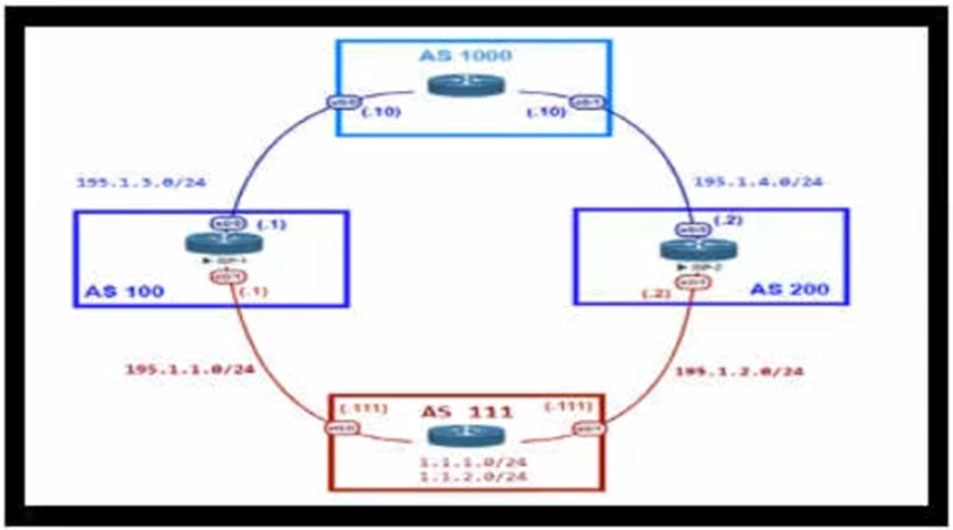
Refer to the exhibit. An engineer is designing the network for a multihomed customer running in AS 111 AS 111 does not have any other ASs connected to it.
Which technology is more comprehensive to use in the design to make sure that the AS is not being used as a transit AS?
- AInclude an AS path access list to send routes to the neighboring ASs that only have AS 111 in the AS path field.
- BConfigure the AS-set attribute to allow only routes from AS 111 to be propagated to the neighbor ASs.
- CUse the local preference attribute to configure your AS as a "non-transit" AS.
- DInclude a prefix list to only receive routes from neighboring ASs.
Correct Answer:
A
A
send
light_mode
delete
Question #44
Which interconnectivity method offers the fastest convergence in the event of a unidirectional issue between three Layer 3 switches connected together with routed links in the same rack in a data center?
- AFiber Ethernet connectivity with UDLD enabled
- BCopper Ethernet connectivity with UDLD enabled
- CFiber Ethernet connectivity with BFD enabledMost Voted
- DCopper Ethernet connectivity with BFD enabled
Correct Answer:
C
C
send
light_mode
delete
Question #45
You want to mitigate failures that are caused by STP loops that occur before UDLD detects the failure or that are caused by a device that is no longer sending
BPDUs. Which mechanism do you use along with UDLD?
BPDUs. Which mechanism do you use along with UDLD?
send
light_mode
delete
Question #46
Company XYZ needs advice in redesigning their legacy Layer 2 infrastructure. Which technology should be included in the design to minimize or avoid convergence delays due to STP or FHRP and provide a loop-free topology?
- AUse BFD.
- BUse switch clustering in the core/distribution layer.Most Voted
- CUse spanning-tree PortFast.
- DUse switch clustering in the access layer.
Correct Answer:
B
B
send
light_mode
delete
Question #47
DRAG DROP -
Drag and drop the multicast protocols from the left onto the correct design situations on the right. Not all options are used.
Select and Place:
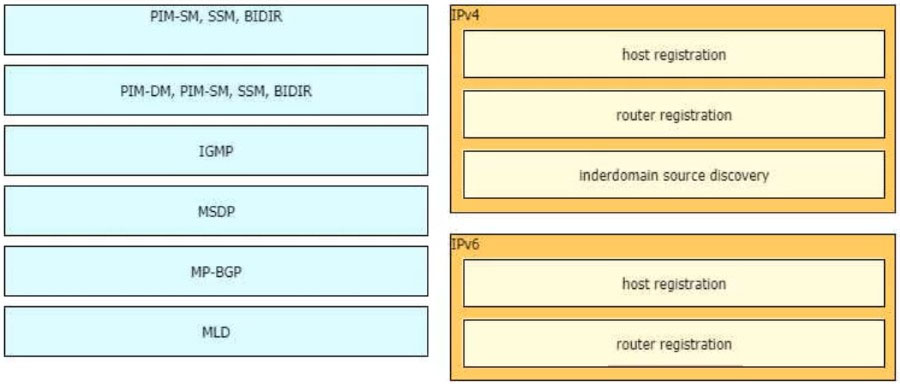
Drag and drop the multicast protocols from the left onto the correct design situations on the right. Not all options are used.
Select and Place:

send
light_mode
delete
Question #48
Which function is performed at the access layer of the three-layer hierarchical network design model?
- Afast transport
- Breliability
- Cfault isolation
- Dredundancy and load balancing
- EQoS classification and marking boundary
Correct Answer:
E
E
send
light_mode
delete
Question #49
Which two features control multicast traffic in a VLAN environment? (Choose two.)
- ARGMP
- BPIM snooping
- CMLD snoopingMost Voted
- Dpruning
- EIGMP snoopingMost Voted
Correct Answer:
DE
DE
send
light_mode
delete
Question #50
In an OSPF network with routers connected together with Ethernet cabling, which topology typically takes the longest to converge?
send
light_mode
delete
All Pages

